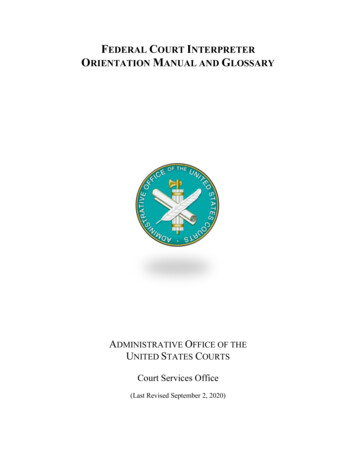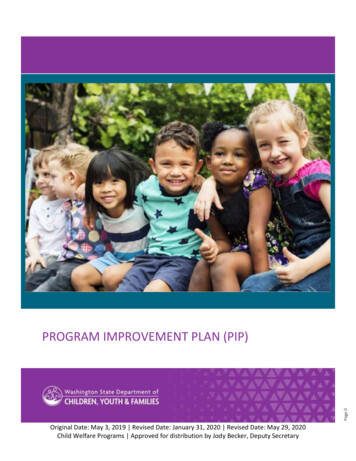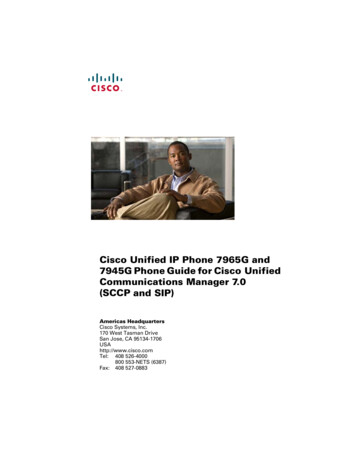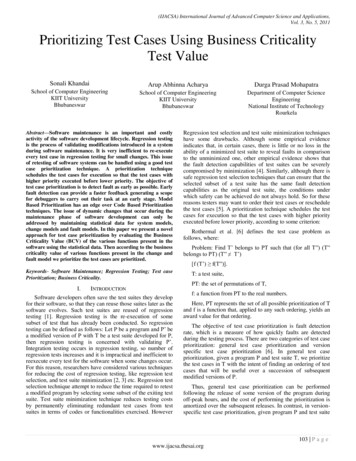
Transcription
(IJACSA) International Journal of Advanced Computer Science and Applications,Vol. 3, No. 5, 2011Prioritizing Test Cases Using Business CriticalityTest ValueSonali KhandaiArup Abhinna AcharyaDurga Prasad MohapatraSchool of Computer EngineeringKIIT UniversityBhubaneswarSchool of Computer EngineeringKIIT UniversityBhubaneswarDepartment of Computer ScienceEngineeringNational Institute of TechnologyRourkelaAbstract—Software maintenance is an important and costlyactivity of the software development lifecycle. Regression testingis the process of validating modifications introduced in a systemduring software maintenance. It is very inefficient to re-executeevery test case in regression testing for small changes. This issueof retesting of software systems can be handled using a good testcase prioritization technique. A prioritization techniqueschedules the test cases for execution so that the test cases withhigher priority executed before lower priority. The objective oftest case prioritization is to detect fault as early as possible. Earlyfault detection can provide a faster feedback generating a scopefor debuggers to carry out their task at an early stage. ModelBased Prioritization has an edge over Code Based Prioritizationtechniques. The issue of dynamic changes that occur during themaintenance phase of software development can only beaddressed by maintaining statistical data for system models,change models and fault models. In this paper we present a novelapproach for test case prioritization by evaluating the BusinessCriticality Value (BCV) of the various functions present in thesoftware using the statistical data. Then according to the businesscriticality value of various functions present in the change andfault model we prioritize the test cases are prioritized.Keywords- Software Maintenance; Regression Testing; Test casePrioritization; Business Criticality.I.Regression test selection and test suite minimization techniqueshave some drawbacks. Although some empirical evidenceindicates that, in certain cases, there is little or no loss in theability of a minimized test suite to reveal faults in comparisonto the unminimized one, other empirical evidence shows thatthe fault detection capabilities of test suites can be severelycompromised by minimization [4]. Similarly, although there issafe regression test selection techniques that can ensure that theselected subset of a test suite has the same fault detectioncapabilities as the original test suite, the conditions underwhich safety can be achieved do not always hold. So for thesereasons testers may want to order their test cases or reschedulethe test cases [5]. A prioritization technique schedules the testcases for execution so that the test cases with higher priorityexecuted before lower priority, according to some criterion:Rothermal et al. [6] defines the test case problem asfollows, where:Problem: Find T’ belongs to PT such that (for all T”) (T”belongs to PT) (T” T’)[f (T’) f(T”)].T: a test suite,PT: the set of permutations of T,INTRODUCTIONSoftware developers often save the test suites they developfor their software, so that they can reuse those suites later as thesoftware evolves. Such test suites are reused of regressiontesting [1]. Regression testing is the re-execution of somesubset of test that has already been conducted. So regressiontesting can be defined as follows: Let P be a program and P’ bea modified version of P with T be a test suite developed for P,then regression testing is concerned with validating P’.Integration testing occurs in regression testing, so number ofregression tests increases and it is impractical and inefficient toreexecute every test for the software when some changes occur.For this reason, researchers have considered various techniquesfor reducing the cost of regression testing, like regression testselection, and test suite minimization [2, 3] etc. Regression testselection technique attempt to reduce the time required to retesta modified program by selecting some subset of the exiting testsuite. Test suite minimization technique reduces testing costsby permanently eliminating redundant test cases from testsuites in terms of codes or functionalities exercised. Howeverf: a function from PT to the real numbers.Here, PT represents the set of all possible prioritization of Tand f is a function that, applied to any such ordering, yields anaward value for that ordering.The objective of test case prioritization is fault detectionrate, which is a measure of how quickly faults are detectedduring the testing process. There are two categories of test caseprioritization: general test case prioritization and versionspecific test case prioritization [6]. In general test caseprioritization, given a program P and test suite T, we prioritizethe test cases in T with the intent of finding an ordering of testcases that will be useful over a succession of subsequentmodified versions of P.Thus, general test case prioritization can be performedfollowing the release of some version of the program duringoff-peak hours, and the cost of performing the prioritization isamortized over the subsequent releases. In contrast, in versionspecific test case prioritization, given program P and test suite103 P a g ewww.ijacsa.thesai.org
(IJACSA) International Journal of Advanced Computer Science and Applications,Vol. 3, No. 5, 2011T, we prioritize the test cases in T with the intent of finding anordering that will be useful on a specific version P’ of P.Version-specific prioritization is performed after a set ofchanges have been made to P and prior to regression testing P’.Because this prioritization is accomplished after P’ is available.General test case prioritization does not use information aboutspecific modified versions of P, whereas version-specificprioritization does use such information.Prioritization can again be categorized as Code Based TestCase Prioritization and Model Based Test Case Prioritization[7]. Most of the test case prioritization methods are code based.Code Based Test Case Prioritization methods are based on thesource code of the system. Code based test case prioritizationtechniques are dependent on information relating the tests oftest suite to various elements of a system’s code of the originalsystem i.e. it can utilize the information about the number ofstatements executed or the number of blocks of code executed.Model Based Test Case Prioritization methods are based on thesystem models. System modeling is widely used to modelstate-based system. System models are used to capture someaspects of the system behavior. Several modeling languagehave been developed such as Extended Finite State Machine(EFSM) and Specification Description Language (SDL).Test case prioritization is ordering the test cases in a testsuite to improve the efficiency of regression testing. Regressiontesting is a process of retesting the modified system using theold test suite to have confidence that the system does not havefaults. During retesting of the system developers face the issueof ordering the tests for execution, which can be addressedusing a good prioritization technique. One of the objectives oftest case prioritization is ’early fault detection rate’, which is ameasure of how quickly faults are detected during testingprocess. Here a metric is used which calculates the averagefaults found per minute and also with the help of APFD(Average Percentage of Faults Detected) metric theeffectiveness of the prioritized and non-prioritized case iscompared [8,9]. The APFD is calculated by taking theweighted average of the number of faults detected during therun of the test suite.APFD can be calculated using the following notations:Let T the test suite under evaluation,m the number of faults contained in the program undertest P,n the total number of test casesAnd TFi the position of the first test in T that exposes fault i.(1)But calculating APFD is only possible when priorknowledge of faults is available. Various experiment wereconducted in which the rate of fault detection for each test caseis calculated and order of test suite is evaluated in decreasingorder of the value of rate of fault detection. Then the APFDvalue is determined for both the prioritized and non-prioritizedtest suite and it is found that the APFD value of prioritized testsuite is higher than the non-prioritized test suite.The rest of the paper is organized as follows: Section 2summarizes the related works. Discussions and the analysis ofour proposed methodology are given in Section 3. Section 4presents a case study: Shopping Mall Automation System.Comparison with the related work is discussed in section 5.The paper concludes in Section 6 and Future works arehighlighted in section 7.II.RELATED WORKSrivastava et al.[11] proposed a prioritization technique andalso used a metric called APFD (Average Percentage of FaultsDetected) for calculating the effectiveness of the test caseprioritization methods. The disadvantage of the methodproposed is that calculation of APFD is only possible whenprior knowledge of faults is available. APFD calculationstherefore are only used for evaluation of effectiveness ofvarious prioritization techniques.Rothermel et al. [6, 8, 10] presented 21 different techniquesfor code based test case prioritization, which are classified intothree different groups i.e. comparator group, statement levelgroup and function level group. To measure the effectivenessof these techniques, an experiment was conducted where 7different programs were taken. Here several dimensions likegranularity were taken for test case prioritization. The maindisadvantages of code based test case prioritization are it isvery expensive as its execution is slow because of theexecution of the actual code and code based test caseprioritization may not be sensitive to the correct or incorrectinformation provided by the testers or the developer.Srikanth et al. [12] presented a technique that extend thecode-coverage TCP techniques and apply test caseprioritization at a system-level for both new and regressiontests. Here the advantage is that the author uses a system leveltest case prioritization techniques which is called thePrioritization of Requirements for Test (PORT) basedtechniques.The PORT technique prioritizes system test cases basedupon four factors: requirements volatility, customer priority,implementation complexity, and fault proneness of therequirements. System level test case prioritization techniquesare very beneficial because it improve the rate of fault detectionof severe faults. PORT technique requires the team to conductsystem analysis and write concrete test cases. The act ofwriting concrete test cases immediately after requirementsspecification can lead to the identification of ambiguous andunclear requirements, allowing requirements errors to beidentified and rectified earlier.The PORT technique allows the engineering team tomonitor the requirements covered in system test; the ability tomonitor requirements covered in system test is believed to beone of the challenges faced by the industry. But here only theexperiment is done for four projects developed by students inadvanced graduate software testing class. So the authors haveto test the scalability of the PORT method.Korel et al.[13, 14] present a model based test caseprioritization method which can be used for any modificationof the EFSM (Extended Finite State Machine) system model.104 P a g ewww.ijacsa.thesai.org
(IJACSA) International Journal of Advanced Computer Science and Applications,Vol. 3, No. 5, 2011Here an experimental study is done which is used tocompare the early fault detection of the various test caseprioritization techniques presented in this paper i.e. randomprioritization, two version of selective prioritization (version I& II) and model dependence-based test case prioritization.Here the author used RP (d), the most likely relative position ofthe first failed test that detects fault d to measure the early faultdetection. The experimental result show that the version II ofselective prioritization and model-dependence basedprioritization may improve the effectiveness of the test caseprioritization. But here in this paper the author used very smallmodel for the test case prioritization, so the effectiveness of themodel based test case prioritization method can’t notunderstand properly. Also in this paper a fixed model is usedi.e here the model is not changed in the system. In the furtherwork Korel et al. [14] present model-based test caseprioritization methods in which information about the systemmodel and its behavior is used to prioritize the test suite forsystem retesting. There are several model based testprioritization methods are present in this paper. Such asSelective test prioritization, Heuristic #1 test prioritization,Heuristic #2 test prioritization, Heuristic #3 test prioritizationand Model dependence-based test prioritization. In selectivetest prioritization techniques high priority is assigned to thosetest cases that execute modified transitions in the modifiedmodel. A low priority is assigned to those test cases that do notexecute any modified transition. And Heuristics #1, #2 and #3have been developed for modifications with multiple markedtransitions. The idea of model dependence-based testprioritization is to use model dependence analysis [15] toidentify different ways in which added and deleted transitionsinteract with the remaining parts of the model and use thisinformation to prioritize high priority tests. Here the authorshave done a experimental study and from the experimentalstudy it indicate that model based test prioritization techniquesmay improve on average the effectiveness of early faultdetection as compared to random prioritization techniques.Korel et al.[7] presented a comparison between codebasedand model-based test case prioritization. The results from theexperimental study indicate that model-based test prioritizationdetects early fault as compare to code-based test prioritization.However due to the sensitiveness property the early faultdetection of model-based prioritization may be deteriorate ifincorrect response is given by the tester or the developer. Themodel-based test case prioritization is less expensive than thecode-based test case prioritization because execution of themodel is faster than the execution of the whole code.Acharya et al.[16] presented a method for prioritize the testcases for testing component dependency in a Component BasedSoftware Development (CBSD) environment using GreedyApproach. Here the author first convert the system model i.e.sequence diagram to An Object Interaction Graph (OIG) usingan algorithm. Then the OIG is traversed to calculate the totalnumber of inter component object interactions and intracomponent object interactions. Depending upon the number ofinteractions between the object an objective function iscalculated and then the test cases are ordered accordingly.Swain et al.[17] proposed an approach to generate test casesand prioritize those test cases based on a test case prioritizationmetric. Here the author has used UML sequence and activitydiagrams for their purpose. The sequence and activity diagramsare converted into testing flow graph (TFG) from which testcases are generated. Then the TFG is converted to a modeldependency graph (MDG). Next, he calculated various weightsfor nodes (message-method/activity) as well as edge(condition) of the MDG based on a rational criterion. Weight ofthe node is calculated by using the number of nodes in ForwardSlice (NFS) of node of MDG and weight of the edge iscalculated by multiplication of the number of incoming controldependencies (edges) of node Ni and the number of outgoingcontrol dependencies (edges) of node Nj. After calculating theweights of the node and edge the he calculated the weight ofthe basic path by adding the weight of the node and edge. Thenhe prioritized the test case in descending order of the weight.Kumar et al.[18] have proposed a new approach whichconsiders the severity of faults based on requirementprioritization. They considered four different factors to assignthe weights to the requirements: Business Value Measure(BVM), Project Change Volatility (PCV), DevelopmentComplexity (DC), and Fault Proneness of Requirements. Tocalculate the Total percentage of fault detected (TSFD), theauthor used severity measure(SM) of each fault. Once the faulthas been detected then they assign some severity measure toeach fault according to requirement weights, to which it ismapped. Total Severity of Faults Detected (TSFD) is thesummation of severity measures of all faults identified for aproduct.Mall et al.[19] presented a method for model basedapproach to prioritize regression test cases for object orientedprograms. Here the author represents all relevant objectoriented features such as inheritance, polymorphism,association, aggregation and exception. Here the authors alsoincluded dynamic aspects such as message path sequencesfrom UML sequence diagrams. The author also considered thedependencies among test cases for test case prioritization. Herethe author named their proposed model as Extended ObjectorientedSystem Dependence Graph (EOSDG). This model extendsLH-SDG and includes exceptions and message path sequencinginformation. The author named their prioritized techniques asModel-based Regression Test Case Prioritization technique.This approach involves two activity diagrams one activitydiagram represent the activities that are performed before thetesting process and the second activity diagram represent theactivities that are performed each time a software is modified.The author constructed a backward slicing of the EOSDG nthen constructed a backward slicing of the EOSDG and thecollect the model elements in both the slicing and then heprioritized the test cases in descending order of the coverage ofthe model elements.III.PROPOSED METHODOLOGYIn this section we discuss our proposed approach togenerate a prioritize test cases. Our approach consists of thefollowing three steps.a) Maintaining a repository.105 P a g ewww.ijacsa.thesai.org
(IJACSA) International Journal of Advanced Computer Science and Applications,Vol. 3, No. 5, 2011b) Matching the project type of the new projects onwhich regression test has to be performing with the existingprojects contained in the repository and identifying theaffected functions. Assigning business criticality values to theaffected functions using statistical data stored in therepository.c) Prioritizing the test cases according to the BusinessCriticality Test Value (BCTV) of the test cases in descendingorder.The framework of proposed methodology is shown in Fig.1. The input to our proposed approach is activity diagram of thenew project.Fig. 1. Framework of the Proposed MethodologyAs shown in Fig. 1 we first map our new project with therepository and then we found out the affected functions due tothe change in the new project. After that we found out the BCV(Business Criticality Value) of each function. Then we traversethe activity graph of the new project. Using the BCV, wecalculate the BCTV (Business Criticality Test Value) of eachtest case are found out. Finally, we prioritize the generated testcases according to BCTV.B. Maintaining RepositoryA repository is maintained for various historical projects ofdifferent category. Before maintaining the repository, ahistorical search is perform for finding various existing projectsof unrelated categories such as application projects, networkingprojects, database projects, etc. for satisfying different needs ofthe end user. After finding out various projects belonging todifferent category, a table is update for each project whichkeeping track of following information. First the types of changes that have occurred duringthe maintenance of the project satisfying the enduser’s requirements are identified.Secondly different functions that are being affecteddue to the changes occurred in the projects have alsobeen maintained, which will help us in finding out theprioritized test case. The affected functions can beidentified for each change of the project with the helpof foreword slicing method and expertise judgments.Foreword slicing method is applied to the particularnode which are being added or changed according theend user’s requirements.The affected functions have been calculated with the helpof foreward slicing algorithm which is shown in the Algorithm1.ALGORITHM1: FOREWARD SLICING ALGORITHM:Input: An activity Diagram that has a single start node andan empty set of node identifiers associated with each node.Output: Forward slice of each node.1) Initialization: Set Si ϕ and Vi 0 for i. where Siis the set associated with node Ni and V denotes thevisited status of node Ni.2) Call ForwardSlice(start node)3) ForwardSlice (node Ni)4) Begin5) if Vi 16) exit(0);7) else8) begin Vi 1/* Mark node as visited*/9) Find Fi Ni N(i 1) depends on Ni10) Set Si Si U Fi11) for(each node Ni ϵ Fi )12) ForwardSlice (Ni);/*Function calledrecursively*/13) End14) end if15) endFor example different projects is having C1, C2, C3.Cntypes of changes which are affecting functions from the set offunction. F1, F2, F3.Fn types of function. The types ofchanges and the list of affected functions are given in Table 1.The Table 1 maintains three attributes such as Project ID,Types of change and affected functions. From the Table II it isfound that Project-1 under gone C1, C2 and C3 types ofchanges. C1 is affecting F1, F2, F4, F6, F7, F8, F10, F12, F13,F15 functions, C2 is affecting F1, F5, F6, F7, F8, F9, F11, F12,F14, F15 types of functionalities and C3 is affecting F2, F3, F4,F8, F9, F10, F11, F12, F13 functionalities. In this similarmanner information for other projects undergone regressiontest have also been maintained in the repository table.C. Evaluating Business Criticality ValueIn this section whenever regression testing has to carry on anew project, the business criticality value of the variousaffected functions have been calculated in the followingmanner. Suppose a new project has encountered along with theinformation with us about the subsequent changes that theproject has undergone according to the customer requirement.Then we will first match the new project with the existingprojects that are maintained in the repository. After finding outthe matching project during the matching process we will thenfind out the function that are being affected due to the changesoccurred in the new project from the repository.For example we encountered a new project P NEW1 havingchanges C2, C7, C9 which match with the project PID 2 fromthe repository then we will find that function F3, F4, F5, F6,106 P a g ewww.ijacsa.thesai.org
(IJACSA) International Journal of Advanced Computer Science and Applications,Vol. 3, No. 5, 2011F7, F8, F10, F11, F12, F13, F15 that have been affected by thechange C2, factors F2, F3, F4, F5, F8, F9, F10, F11, F12, F14,F15 have been affected by the change C7 and factors F2, F4,F6, F8, F10, F12, F14, F15 have been affected by the changeC9. Since the new project P NEW1 with changes C2, C7, C9matches with the PID 2 type. The affected functions are listedin Table 2.Table 1. Repository Tableinformation such as the function name along with the averageinteraction and the BCV value of each function.D. 3.3 Prioritizing Test CasesIn this section the test cases are prioritized according to theBusiness Criticality Values of the different factors. Everytestcase executes different factors of a project according to theDepth First Search (DFS) of individual test cases are identifiedknown as Business Criticality Test Value (BCTV) of that testcase the project. And every factor is having different BusinessCritical Values.Initially different test cases are identified and BCTV of thefunction that is encounter during the traversal process. This isshown in Table 4. Then we ordered our test cases indescending order of the Business Criticality Values.Table.3. Business Criticality Value (BCV) TableTable. 2. Change Detail NewThe Table 2 stores the information about the changes thatare being made in the new project along with the functions thatare being affected.Further the Business Criticality Value (BCV) of the variousfunctions is found out. A Business Criticality Value (BCV) isdefined as the “amount of the function contribution towards thesuccess of the project implementation.” For example in aBanking Automation Software, there are two activities such asto do transaction and collect feedback. The money transactionactivity will be having higher BCV than the feedbackcollection activity.The Business Critical Test Value is calculated as follows: First find out those functions that are being affecteddue to the changes made in the project. Find out the average interaction of each functionwithin that project.The Business Critical Value is calculated by the followingformula 2.BCV (Fn) (2)Now the BCV of each functionality have been calculatedaccording to the formula and the value has been store in theTable 3. BCV table i.e. Table 3 stores certain kind ofPRIORITIZATION ALGORITHM:Our proposed technique to prioritize regression test cases isalgorithmically represented in algorithm 2.Algorithm 2:1. Maintain a repository which contains different typesof projects, no. of changes and the affectedfunctionality due to the changes.2. Matching the new project with the repository andidentifying the no. of changes and the affectedfunctions respectively.3. Calculate the business criticality value of eachfunction according to the equation 2.4. Then traverse the activity diagram of the new comingproject with the help of DFS with individual test case.5. Find the BCTV of each test case by adding the BCVvalue of each factor.6. Then prioritize the test cases according to thedescending order of BCTV for each test case.107 P a g ewww.ijacsa.thesai.org
(IJACSA) International Journal of Advanced Computer Science and Applications,Vol. 3, No. 5, 2011Table. 4. Prioritization TableAfter the project have been submitted, it was found thatthere was a need of some additional functionality for big bazaarapplication so the necessary changes have been made to thesubmitted project, which activity diagram is shown in Fig. 3. Afunctionality detail table has been maintained which store thedifferent types of functions present in the activity diagram ofthe Big Bazaar Automation System and their function id asshown in Table 5.The prioritize table stores the information about the testcases that are obtained after the traversal process. It also storesthe information about the functions that are being encounteredduring the traversal process. Finally we have found out theBCTV of each test case and prioritized the test suite accordingto the descending order of the BCTV values.Hence the prioritize test suite is:t3, t1, t5, t2, t4 or t3, t5, t1, t2, t4 .IV.A CASE STUDY: SHOPPING MALL AUTOMATIONIn this section our proposed approach is described with acase study of a Shopping Mall Automation System. Since inour proposed method we are matching the new projects goesthrough change with the repository to find out the affectedfunctions. So that whenever a new project is encounter we canfind out the affected function.After finding out the affected function from the repositorythe BCV value of each function is calculated. Then the totalBCTV value of each test case is calculated by adding theBCTV value of those functions that are visited during the DFStraversal of the Activity Diagram of the new encounter project.Finally the test cases are prioritizing according to descendingorder of their BCTV value. Suppose in the past there was aneed for a big bazaar project.Fig. 3. Activity Diagram for A Big Bazaar Automation SystemThe types of changes that have been made in the projectwith the functionalities that have been affected by the changeshave been maintained in a repository which is shown in Table6.In our project there are three numbers of changes have beenmade. C1 change is for payback card. C2 change is for couponoption and C3 change is for SIM card option. The changesmade are highlighted through dotted line in the activitydiagram of the project which is shown in Fig. 3.Fig. 2. Activity Diagram of Shopping Mall Automation SystemSo projects have been designed whose activity diagram isshown in Fig. 2.A. Matching a project with the repositorySuppose we now encounter a new shopping mall projectwhich Activity Diagram is shown in Fig. 4. We found that thenew project matches to the big bazaar project and having C1and C2 types of changes those are highlighted in through dottedline in Fig. 4. Now we match it with the repository and find theaffected functionalities due to the changes C1 and C2. This isshown in Table 7.108 P a g ewww.ijacsa.thesai.org
(IJACSA) International Journal of Advanced Computer Science and Applications,Vol. 3, No. 5, 2011Table. 8. Business Criticality Value (BCTV) TableNow the BCV of each functionality have been calculatedaccording to the formula 2 and the value has been store in theTable 8.Table.5. Functionality Detail TableNow the activity diagram shown in Fig.4 has been traversedaccording to the Depth First Search (DFS) and the traversingfunctionalities of each test case are found out. After that theBCTV of each test cases are calculated by adding the BCVvalue of the functions and all these information have beenmaintained in table 9.Table 9: Prioritization TableFig. 4. Activity Diagram of New ShoppingTable. 6. Repository (A Shopping Mall Project)Table. 7. Affected Function due to the Change in the New ProjectAfter calculating the BCTV value of all the test cases wethan prioritized the test suite according to the descending orderof the BCTV values of the test cases.Hence The Prioritize Test Sequence is:t16, t15, t6, t11, t5, t10, t13, t12, t3, t8, t2, t7, t14, t4, t9, t1109
General test case prioritization does not use information about specific modified versions of P, whereas version-specific prioritization does use such information. Prioritization can again be categorized as Code Based Test Case Prioritization and Model Based Test Case Prioritization [7].
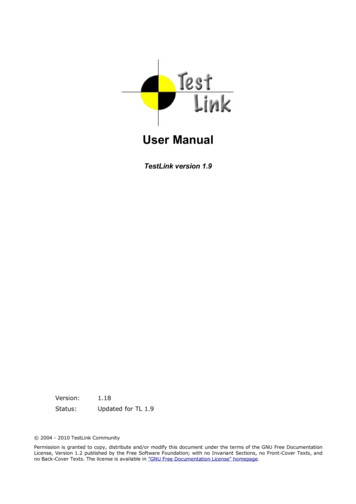
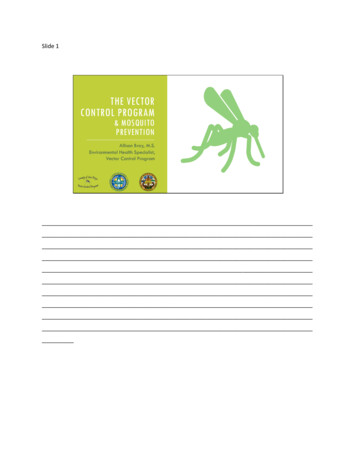
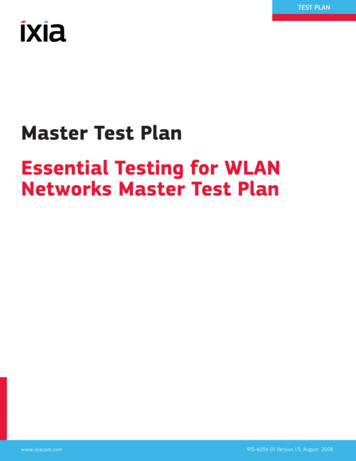


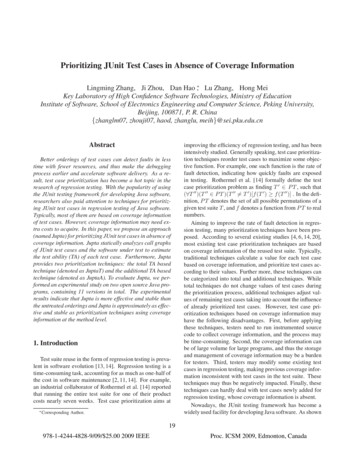
![Service Catalog-Spain.ppt [Modo de compatibilidad]](/img/19/servicecatalog-spain.jpg)

